Climate Risk From ‘Zombie’ Rules
Air Date: Week of May 20, 2022
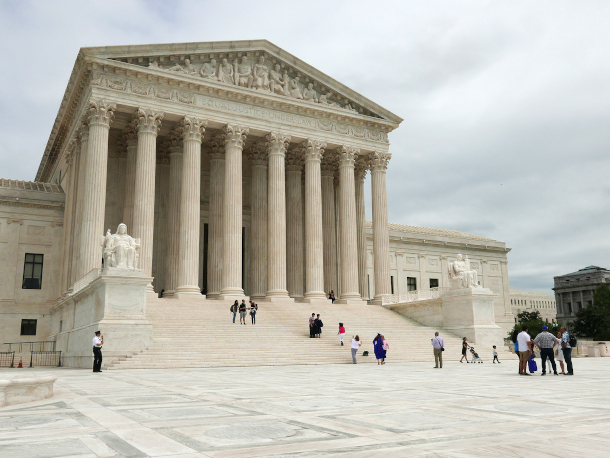
The United States Supreme Court appears poised to place stricter limits on EPA’s regulatory authority in the major climate change case before it, West Virginia v. EPA. (Photo: Susan Melkisethian, Flickr, CC BY-NC-ND 2.0)
The 6-3 conservative majority of the U.S. Supreme Court is apparently poised to constrain climate action by the Environmental Protection Agency in a decision expected before the end of the SCOTUS term in June. The case, West Virginia v. EPA, involves the Obama Clean Power Plan regulations even though those rules no longer exist, and EPA is replacing them. Harvard Law Professor Richard Lazarus joins Host Steve Curwood to explain how a loss for EPA in this case could limit climate policies across multiple agencies.
Transcript
CURWOOD: From PRX and the Jennifer and Ted Stanley Studios at the University of Massachusetts Boston, this is Living on Earth. I’m Steve Curwood.
The Supreme Court of the United States will likely limit what the federal government can do about climate change in a decision expected before the end of June, according to observers. The case called is West Virginia v. EPA, and it’s a battle over the Obama Clean Power Plan, even though that rule was repealed by the Trump Administration. The odd event of the Supreme Court reviewing a withdrawn rule is linked to the Court’s hard swing to the right and related to the rationales revealed in the unprecedented leak of a draft opinion in an abortion case that would repeal Roe vs. Wade. Harvard Law Professor Richard Lazarus says the 2015 Clean Power Plan rule made history with its efforts to rein in carbon emissions from the utility sector.
LAZARUS: It was such an important rulemaking that it led to the Paris agreement only about a month later. The rest of the world needed to see the United States was all in, it was serious, and it was addressing not just the motor vehicle emissions but also addressing the coal fired power plants.
CURWOOD: But just a few months later in 2016 the Supreme Court put the Clean Power Plan on hold and the rule never went into effect before the Trump administration came in and repealed it.
LAZARUS: And then on January 19th, 2021, a day before President Biden was sworn in, the United States Court of Appeals for the DC Circuit basically struck down the repeal and said, you were wrong, Trump Administration, the Clean Power Plan was not invalid, at least for the reasons you gave. And it looked like for that reason, the Clean Power Plan was gonna be revived, as this wonderful gift from the DC Circuit right before the new president took office, right before a lot of those same people who had written the Clean Power Plan in the Obama Administration were coming back into office again. But that's when the case took a detour.
CURWOOD: Yeah, it doesn't sound like it worked out so well, what exactly happened?
LAZARUS: So what happened is this: what most people outside of EPA and the Biden Administraiton saw as a gift, they saw that DC Circuit decision as a disaster, ironically. They saw the DC Circuit's potential revival of the Clean Power Plan as putting them in a terrible situation. While they had fought tooth and nail for that plan in 2016, 2021 was not 2016. And what had changed, among other things was the United States Supreme Court. Justice Merrick Garland was not Justice Merrick Garland, he was not on the court; there were instead three new Trump appointees, and they can count to at least five and probably six justices who would rule the Clean Power Plan probably was invalid in the first instance, they would uphold the Trump repeal. So they were so confident they would lose that case in front of the Supreme Court trying to defend the DC Circuit judgment that they actually unilaterally wrote, quickly, a memo, a motion to the DC Circuit that said, Stop the presses! Don't revitalize the Clean Power Plan, stay your mandate. Why? Because they didn't want the mandate to issue, they didn't want the Clean Power Plan to come back, because they wanted to have no chance the United States Supreme Court would review the case. The DC Circuit did just what it asked to do. It basically said, All right, we won't, no Clean Power Plan is revived, because EPA said we're going to start from square one. And EPA thought, with some reason, as the Department of Justice did, that will be the end of it. But then the Supreme Court surprised everyone one more time. In October of 2021, they granted review in the case, even though the case was really dead. It was just a shock, I think even some of the industry petitioners were shocked the court granted review in October 2021. Because there was no regulation of greenhouse gas emissions from the coal fired plants, EPA had made clear they weren't reviving the Clean Power Plan, it hadn't been revised by the DC Circuit, EPA was going to take another year, year and a half to write a new plan. When the court took the case, everyone knew what that meant. That meant the Supreme Court planned to reverse the DC Circuit, there is no other reason to take the case. And they plan to do probably just what EPA didn't want them to do: not just reverse, but potentially reverse on broad, sweeping grounds, of the kind that would limit what EPA could do now, under the Clean Air Act, even before EPA had a chance to try to do it. So that's what happened in October. And that's basically what everyone's been waiting for ever since, and the case was argued on February 28th, 2022. And the decision will come out by the end of June.
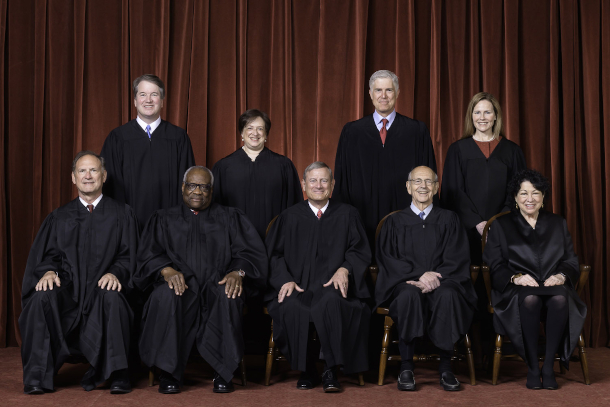
The Supreme Court as composed October 27, 2020 to present. Front row, left to right: Associate Justice Samuel A. Alito, Jr., Associate Justice Clarence Thomas, Chief Justice John G. Roberts, Jr., Associate Justice Stephen G. Breyer, and Associate Justice Sonia Sotomayor. Back row, left to right: Associate Justice Brett M. Kavanaugh, Associate Justice Elena Kagan, Associate Justice Neil M. Gorsuch, and Associate Justice Amy Coney Barrett. (Photo: Fred Schilling, Collection of the Supreme Court of the United States)
CURWOOD: This sort of now zombie Clean Power Rule that has invited this litigation from the Attorney General of West Virginia and several other red states. I mean, how political is that move? I mean, the thing is officially dead, and yet they're suing.
LAZARUS: Yeah, they see a Supreme Court which is now dominated by at least five, if not six, very conservative justices, and they see an opportunity to make big law. They see an opportunity to have the Supreme Court codify a dominant view among conservative justices these days, that federal agencies don't have capacious authority to address important issues of public health and welfare, unless Congress has written specific language authorizing it. And they're going for a big win here. Once the court granted review, in this case, they're swinging for the fences. They're swinging for a ruling with doesn't just say, which the court could do, in this case, under this language, the Clean Power Plan was unlawful, therefore, the Trump repeal was valid. If the court did that kind of narrow ruling, that would not be a big deal, because EPA is already willing to give up the Clean Power Plan. They're not going for that ruling. They're going for a ruling which says, EPA never has the authority to address important questions of public health and welfare and protect the environment unless the language of the statute specifically authorizes EPA to take the kind of action they're taking in this case.
CURWOOD: Professor Lazarus, this sounds to me like the logic of this leaked draft opinion from the Supreme Court on the Mississippi abortion case, that sort of essentially says, since the Constitution doesn't mention it, we can't allow it.
LAZARUS: Yeah, it's certainly true that in terms of the reinterpretation of the Constitution and reading the statute, there's a similarity between those two things, that you've got actually see specific language in it. You know, the Constitution is different than statutes. But the idea of broad, capacious language not being enough, whether it's broad, capacious language saying, you know, due process and liberty and life, not being enough for abortion, or statutory language not being specific enough. So I think you certainly have put your finger on a parallel between the two.
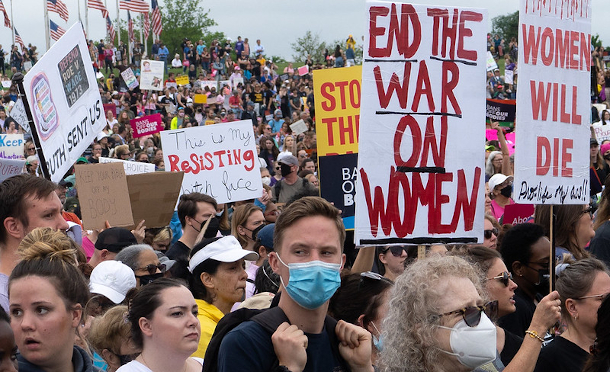
Protesters at the “Bans Off Our Bodies” rally and march against repealing Roe v. Wade in Washington, D.C. on May 14, 2022. (Photo: Victoria Pickering, Flickr, CC BY-NC-ND 2.0)
CURWOOD: Well, right, so I mean, when you saw the leaked draft opinion in this Mississippi case, I think it's called Dobbs versus Jackson, what kind of window did it give you into how the court is operating these days?
LAZARUS: Yeah, here's the thing, Steve, which is, I think, different for me than for a lot of people. I watch the court very closely, I learned nothing. I already knew what kind of court we had. I mean, I listened to their oral argument in the Dobbs case in early December, the abortion case from Mississippi, I listened to oral argument. And that's when I found out how conservative they were going to be in that case. I was somewhat surprised, I thought there was a chance there might be the potential for a more moderate position, which wouldn't overrule Roe v. Wade and the Casey case, but might uphold the Mississippi law on narrow grounds. It wasn't there. The Chief Justice was interested in it, but there were five justices to the right who had no interest at all. So at that point, I knew how conservative the Court was, I knew they were going to, basically there were five justices to overrule Roe v. Wade. So when I saw that leaked draft, I was shocked that it was leaked. But there was nothing about the draft that surprised me. I knew that Alito being Alito would, just like they're trying in the Clean Power Plan case, he would swing for the fences. He would write an over the top, excessive opinion of trying to eviscerate Roe v. Wade and the Casey case, and that's what we saw. I think we'll lose a lot of the excessive rhetoric in it. I don't think Justice Kavanaugh or Barrett will sign on to that. I think that was very much a first draft. But the bottom line, overruling, I think will happen. It didn't tell me anything with the West Virginia case. It just confirmed the fact that this is a court which tends to swing for the fences. I knew that from their grant of cert, which was ridiculous, review, in October. And I also before we saw the leak, I heard the oral argument in the West Virginia case on February 28th. The Solicitor General made a very compelling argument on behalf of the EPA saying, look, there's no regulation going on anymore of these, of these sources. There's no reason to hear this case. I was hoping I might hear some indication they were going to step back from the abyss and not give us a bad ruling. I heard nothing of that on February 28th. I think there are five if not six solid votes for a significant, sweeping ruling against EPA's authority, and an opinion which might actually have a lot of spillover effect, far beyond just this one provision of the Clean Air Act: other provisions of the Air Act, other provisions of the Clean Water Act, the Resource Conservation Recovery Act for hazardous waste, for things that Interior are trying to do. And indeed, and here's my one worry, Steve, and I hope that Justices don't do this because they're listening to your broadcast, but I'm sure they do. It worries me about what they might say in this case, that might affect the SEC's recent proposal to have climate disclosure rules as part of SEC filings. This case, if they write it as broadly as I fear they may, may have very broad, sweeping implications for climate change, writ large in the government, but also not for climate change only: for the ability of federal agencies to regulate public health and welfare concerns based on existing federal law.
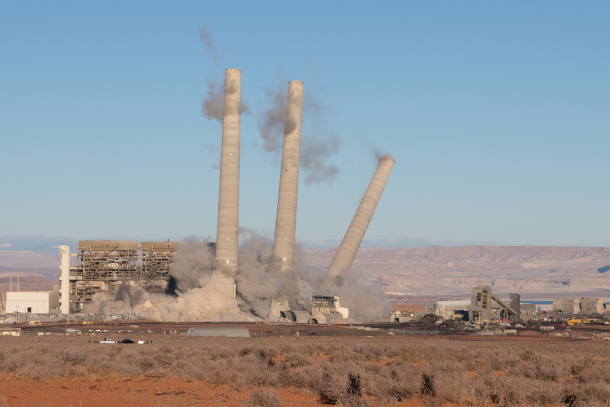
A controlled demolition of the Navajo Generating Station in Arizona on December 18, 2020. Coal-fired power plants in the U.S. like NGS were the main target of the Clean Power Plan and have been closing in recent years as natural gas and renewables replace them (Photo: Alan Stark, Flickr, CC BY-SA 2.0)
CURWOOD: I don't know if it's fair to make the analogy but looking at that draft from Justice Alito, in the abortion case, and the way you describe the arguments around this EPA case, sounds like the High Court is back to the language of Plessy versus Ferguson, that black people have no rights that white people have to respect, and to what extent are we talking about this court saying that the environment and conservation and the way our planet works has no right if it's going to get in the way of commerce and what business wants?
LAZARUS: I don't think they'll say that at all. But what I fear they're gonna say is gonna make it much harder for the federal government to address compelling environmental issues. And here's why. I think what they're likely to say is, that Congress has to speak with specific language to show they really contemplated this kind of regulation. You know, on its face, as a matter of theory, I could defend that, you could defend that: well, if a rule is really important, then Congress should make sure that Congress believes it's the right thing. So in theory that kind of is defensible. Here's the problem. Congress doesn't pass any legislation anymore, and we all know that. So Congress is not going to pass a new Clean Air Act, Clean Water Act to say Oh, Supreme Court, you want more guidance. Here it is. The last time they amended the Clean Air Act was 1990. The last time they amended the Clean Water Act was 1987. The last time they amended the hazardous waste laws: 1984. The last time they amended the endangered species laws: 1973. Congress has gotten out of the lawmaking business because they're subject to congressional paralysis and gridlock writ large. So what the Supreme Court will be doing is setting up a test, which is broad, capacious language is not enough, which is what has been the bedrock of environmental law for the past 50 years, and say you need specific language, when we all know as a practical matter, we're not going to get it, at least in the foreseeable future. And when it comes to issues like climate, time is not neutral. The longer we wait to get that necessary authorization, the exponentially harder it is to address the issue. Given the plight we're in, given the nature of the climate problem, this Court's insistence on this more purified view of separation of powers quickly borders on the irresponsible. Now, here's the one thing I think, though, the Court's not going to do, and I've heard some people say they're worried the Court will do it. They're not going to overrule Massachusetts versus EPA.
CURWOOD: Why not? They're on a, on a roll here to pretty much move things as hard to the right as they as they dare.
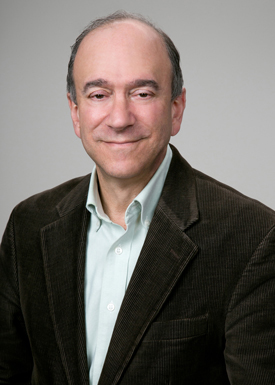
Richard Lazarus is a Professor at Harvard Law School and has presented oral argument before the Supreme Court in 14 cases. (Photo: Courtesy of Harvard University Press)
LAZARUS: Yeah, and here's why they're not going to do it. It's really for two reasons. The first is, it's not a question presented in the case. No party in the case asked to overrule Massachusetts versus EPA, it's jurisdictionally not a question presented. It wasn't briefed by the parties, it wasn't argued by the parties. Unlike the Dobbs abortion case, Roe v. Wade, it was a question presented, it was briefed by the parties and argued by the parties. In fact, in oral argument in this case, Lindsay See, the Solicitor General said, we are not asking this court to overrule Massachusetts versus EPA. The other thing I want to point out is as disastrous as I worry the Supreme Court's opinion might be in this case, and the kind of effect it will have, I don't think it's going to eliminate every way that EPA can actually regulate greenhouse gases. EPA has lots of, of tools under the Air Act to regulate the sources of greenhouse gases in ways other than focusing on greenhouse gases per se. For instance, if they regulate more stringently other pollutants those sources put out, and there's good scientific reason to do it, based on the harm caused by those other pollutants, whether it's sulfur oxides, particulate matter, nitrogen oxides, or mercury, if they regulate those sources strictly under those other more traditional criteria, guess what? Those pollution control requirements will, incidentally, bring down greenhouse gas emissions. They also may change the economics of those existing coal fired power plants, and to what extent they're economically viable. EPA can do the same by finally regulating, as they could have for years, coal ash put out by those coal fired power plants. They've got the discretion, they've got the science right now to regulate coal ash as a hazardous waste under the Resource Conservation Recovery Act. If they do that, you know, changes completely the economic viability of those coal fired power plants. So EPA has a lot of things they can do that are not directly climate related to go after some of the biggest sources that we have, and that's the coal fired power plants.
CURWOOD: Richard Lazarus is the Howard and Katherine Aibel Professor of Law at Harvard Law School. Thank you so much, Professor Lazarus.
LAZARUS: Thanks, Steve. It's always a pleasure and a treat for me.
Links
The Washington Post | “Supreme Court leak strikes fear among environmental lawyers”
Living on Earth wants to hear from you!
Living on Earth
62 Calef Highway, Suite 212
Lee, NH 03861
Telephone: 617-287-4121
E-mail: comments@loe.org
Newsletter [Click here]
Donate to Living on Earth!
Living on Earth is an independent media program and relies entirely on contributions from listeners and institutions supporting public service. Please donate now to preserve an independent environmental voice.
NewsletterLiving on Earth offers a weekly delivery of the show's rundown to your mailbox. Sign up for our newsletter today!
 Sailors For The Sea: Be the change you want to sea.
Sailors For The Sea: Be the change you want to sea.
 The Grantham Foundation for the Protection of the Environment: Committed to protecting and improving the health of the global environment.
The Grantham Foundation for the Protection of the Environment: Committed to protecting and improving the health of the global environment.
 Contribute to Living on Earth and receive, as our gift to you, an archival print of one of Mark Seth Lender's extraordinary wildlife photographs. Follow the link to see Mark's current collection of photographs.
Contribute to Living on Earth and receive, as our gift to you, an archival print of one of Mark Seth Lender's extraordinary wildlife photographs. Follow the link to see Mark's current collection of photographs.
 Buy a signed copy of Mark Seth Lender's book Smeagull the Seagull & support Living on Earth
Buy a signed copy of Mark Seth Lender's book Smeagull the Seagull & support Living on Earth

